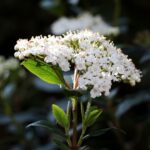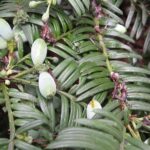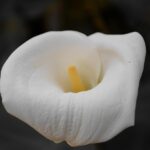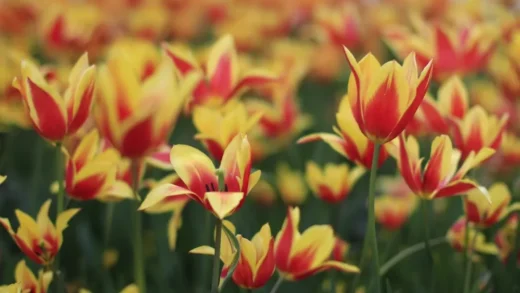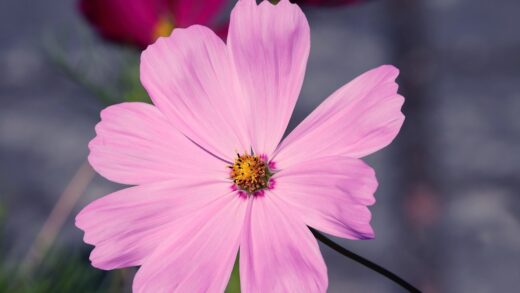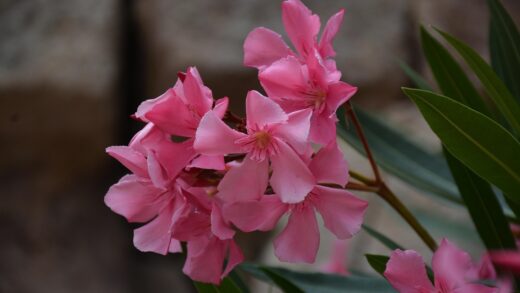While the Balkan bellflower is celebrated for its robust and generally trouble-free nature, it is not entirely impervious to the challenges posed by common garden diseases and pests. A vigilant gardener who understands the potential threats can take preventative measures and act swiftly to mitigate any problems that arise. Most issues are minor and can be managed with simple cultural practices, such as ensuring good air circulation and proper soil drainage. The most common adversaries are fungal diseases, which thrive in damp conditions, and sap-sucking or foliage-chewing invertebrates. By familiarizing yourself with the signs and symptoms of these potential problems, you can ensure your plants remain healthy, vigorous, and beautiful throughout the growing season, preserving the integrity of their lush foliage and abundant blooms.
The key to managing pests and diseases on Balkan bellflower is rooted in prevention. A healthy, thriving plant growing in its ideal conditions—well-drained soil, adequate sunlight, and proper spacing—is inherently more resistant to attack than a plant that is stressed. Stressed plants, whether from too much water, too little light, or poor nutrition, have weakened natural defenses, making them an easy target. Therefore, the first line of defense is always to provide the best possible growing environment. Good garden hygiene, such as clearing away dead leaves and debris from around the base of the plant, can also help to eliminate potential hiding spots for pests and overwintering sites for fungal spores.
Regular inspection of your plants is the second pillar of effective pest and disease management. Taking the time to look closely at the leaves, stems, and flowers can help you catch problems in their earliest stages when they are much easier to control. Look for anything out of the ordinary: discolored spots, distorted growth, fine webbing, or the physical presence of insects. Check the undersides of the leaves, a common hiding place for pests like aphids and spider mites. Early detection allows for targeted intervention, often with simple mechanical or organic methods, preventing the need for more drastic chemical treatments later on.
When intervention is necessary, it is always best to start with the least toxic and most environmentally friendly option. A strong jet of water from a hose can dislodge many common pests. Hand-picking larger pests like slugs and snails can be very effective in small gardens. If these methods are insufficient, consider organic controls like insecticidal soap, neem oil, or horticultural oils. These products are generally less harmful to beneficial insects and the wider ecosystem than synthetic chemical pesticides. A proactive and integrated approach to pest management will keep your Balkan bellflower healthy while maintaining a balanced garden environment.
Common fungal diseases
Among the potential diseases that can affect the Balkan bellflower, fungal issues are the most common, particularly in certain weather conditions. Powdery mildew is perhaps the most frequently encountered problem. It manifests as a conspicuous white or grayish, dusty-looking coating on the surfaces of leaves, stems, and sometimes even the flowers. While it is unsightly and can reduce the plant’s vigor by interfering with photosynthesis, it is rarely fatal. Powdery mildew thrives in conditions of high humidity, warm days, and cool nights, and it is most prevalent in gardens with poor air circulation.
More articles on this topic
Preventing powdery mildew is more effective than trying to cure it. Ensure you provide adequate spacing between plants from the outset to promote good airflow. Watering the plants at their base with a soaker hose or drip irrigation, rather than with overhead sprinklers, helps to keep the foliage dry and less hospitable to fungal spores. If powdery mildew does appear, you can try to control its spread by removing and destroying the most heavily infected leaves. For more persistent infections, spraying with a fungicide based on sulfur, potassium bicarbonate, or neem oil can be effective, but applications should begin at the first sign of the disease.
Another fungal disease to be aware of is rust. Rust diseases appear as small, rust-colored or orange-yellow pustules, typically on the undersides of the leaves. If you wipe a finger across these pustules, a colored powder—the fungal spores—will come off. A severe infection can cause leaves to yellow and drop prematurely, weakening the plant. Like powdery mildew, rust fungi favor damp, humid conditions. The same preventative measures of ensuring good air circulation and avoiding wet foliage are the best lines of defense against this disease.
Root rot is the most serious and potentially fatal disease for the Balkan bellflower, and it is almost always a direct result of improper growing conditions. This disease is caused by various soil-borne fungi that attack the plant’s root system in overly wet, poorly drained, and anaerobic soils. The symptoms above ground include wilting (even when the soil is wet), yellowing leaves, and stunted growth. Below ground, the roots will be brown, mushy, and decayed. There is no effective cure for root rot once it has taken hold, which underscores the absolute necessity of planting this species in soil with excellent drainage.
Prevalent insect pests
The Balkan bellflower’s succulent foliage can be an attractive meal for several common garden pests. Slugs and snails are chief among them, especially in damp, shaded gardens. These mollusks are nocturnal feeders and can cause significant damage by chewing irregular holes in the leaves and sometimes grazing on the flowers. Their presence is often given away by the silvery slime trails they leave behind. Management strategies range from hand-picking them at night to setting up beer traps or using barriers like crushed eggshells or diatomaceous earth around the plants. In cases of severe infestation, iron phosphate-based slug pellets, which are safer for wildlife, can be used.
More articles on this topic
Aphids are another common pest that may be found on the tender new growth and flower buds of the Balkan bellflower. These are small, pear-shaped, sap-sucking insects that can be green, black, or pinkish in color. They feed by piercing the plant tissues and extracting the nutrient-rich sap, which can lead to distorted or stunted growth. Aphids also excrete a sticky substance called honeydew, which can attract ants and promote the growth of black sooty mold. Small infestations can often be managed by simply blasting them off with a strong spray of water from a hose or by wiping them off with a cloth.
Spider mites, which are technically arachnids, can also be a problem, particularly in hot, dry conditions. These tiny pests are difficult to see with the naked eye, but their presence is often indicated by a fine, silky webbing on the undersides of leaves and between stems. They feed by sucking the contents out of plant cells, leading to a stippled or speckled appearance on the leaves, which may eventually turn yellow or bronze and drop off. Increasing humidity by misting the plants can deter spider mites, as they prefer dry environments. Insecticidal soaps or horticultural oils are effective control measures, but thorough coverage, especially on the undersides of leaves, is essential.
Less common but still a potential nuisance are vine weevils. The adult weevils are nocturnal and chew characteristic notches in the edges of the leaves, which is mostly cosmetic damage. The more serious threat comes from their C-shaped, grub-like larvae, which live in the soil and feed on the plant’s roots and crown. A severe larval infestation can cause the plant to wilt and die suddenly. This pest is particularly problematic for plants grown in containers. Biological control using pathogenic nematodes (Steinernema kraussei), applied as a soil drench in the autumn, is a very effective and environmentally safe way to control the destructive larval stage.
Prevention strategies
The most effective approach to dealing with pests and diseases is to prevent them from becoming a problem in the first place. This begins with creating a healthy growing environment that caters to the specific needs of the Balkan bellflower. The single most important factor is providing well-drained soil. This cannot be overstated, as it is the primary defense against the deadly threat of root rot. Amending heavy soils with organic matter and grit is a crucial first step that will prevent a multitude of problems down the line.
Ensuring proper plant spacing is another key preventative strategy. Overcrowding leads to poor air circulation, which creates a stagnant, humid microclimate around the foliage. This is the ideal breeding ground for fungal diseases like powdery mildew and rust. By giving each plant enough space to grow to its mature size, you allow air to move freely, which helps to keep the leaves dry and significantly reduces the risk of fungal spores taking hold. When planting, always consider the plant’s final spread and space accordingly.
Good watering practices are also a cornerstone of disease prevention. As discussed, watering at the base of the plant in the morning is the recommended technique. This delivers water directly to the roots where it is needed, while keeping the foliage dry. Wet leaves, especially overnight, are a primary invitation for fungal diseases. Using soaker hoses or drip irrigation is an excellent way to automate this process and ensure efficient, disease-preventing irrigation. Avoiding the use of overhead sprinklers on susceptible plants is a simple change that can make a big difference.
Finally, promoting biodiversity in your garden is a powerful, long-term strategy for pest management. By planting a variety of flowering plants, you can attract beneficial insects like ladybugs, lacewings, hoverflies, and parasitic wasps. These insects are natural predators of common pests like aphids and spider mites, and they provide a free and continuous pest control service. Reducing or eliminating the use of broad-spectrum chemical pesticides will help to protect these valuable allies and maintain a healthy, balanced garden ecosystem where pest populations are kept in check naturally.
Organic and chemical controls
When preventative measures are not enough and a pest or disease problem requires direct intervention, it is wise to follow an integrated pest management (IPM) approach. This means starting with the least harmful and most targeted control methods first, only escalating to stronger measures if absolutely necessary. For insect pests like aphids and spider mites, a first step is often mechanical removal. A strong jet of water can physically dislodge them, and for many small infestations, this is all that is needed. Hand-picking larger pests like slugs is also a viable mechanical control.
If mechanical methods fail, the next step is to consider organic, low-toxicity sprays. Insecticidal soaps are very effective against soft-bodied insects like aphids and spider mites. They work by disrupting the insect’s cell membranes and are most effective when applied directly to the pest. Neem oil is another excellent organic option; it acts as a repellent, an anti-feedant, and a growth regulator, disrupting the pest’s life cycle. It also has fungicidal properties, making it useful for controlling diseases like powdery mildew. Both of these options have low toxicity to humans and beneficial insects, provided they are applied correctly, usually in the evening when pollinators are less active.
For fungal diseases like powdery mildew, several organic fungicidal sprays are available. Sprays containing potassium bicarbonate work by changing the pH of the leaf surface, making it inhospitable for the fungus to grow. Sulfur-based fungicides have been used for centuries and are also effective, though they can be damaging to some plants in hot weather. A simple homemade remedy of one part milk to nine parts water has also been shown to be surprisingly effective against powdery mildew, especially when applied as a preventative measure in full sun.
The use of synthetic chemical pesticides and fungicides should always be a last resort. While they can be very effective, they are often broad-spectrum, meaning they can harm beneficial insects, pollinators, and other non-target organisms, disrupting the natural balance of your garden ecosystem. If you do choose to use a chemical control, read the label carefully and follow the instructions precisely. Ensure the product is rated for use on ornamental flowering plants and is effective against the specific pest or disease you are targeting. Always wear appropriate protective clothing and apply the chemical in calm weather conditions to avoid drift.







